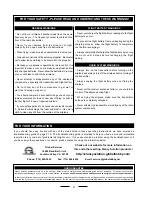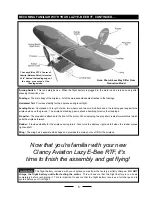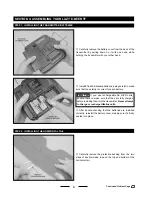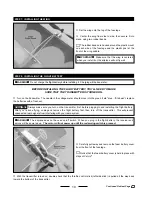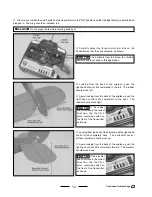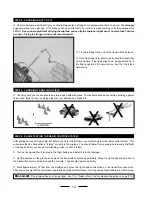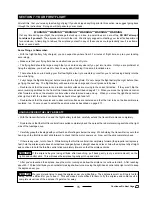
16
PRO TIP
FLYING THE LAZY E-BEE RTF
●
Now that the airplane has climbed to a safe altitude you can begin to learn the basics of flight. General flying should be
done with the motor at full power. You control the altitude of the airplane by moving the right-hand control stick either
forward or back. Moving the stick forward will cause the airplane to pitch down and lose altitude, and moving the control
stick back will cause the airplane to pitch up and gain altitude. These control inputs should be done gently, so you don't
overcontrol the airplane. If the airplane is moving too fast for you, simply throttle back to 1/2 throttle to slow it down.
When the airplane climbs you will notice that it will begin to lose speed. You'll also notice that the airplane
will gain speed when it descends. If you climb too steeply, the airplane may slow down so much that it stops flying and
"stalls." Conversely, if you descend too steeply, the airplane may fly so fast that you begin to lose control. For these
reasons, we suggest using small, gentle control inputs to prevent this from happening.
●
To turn the airplane, you need to move the right-hand control stick in the direction you want the airplane to turn, either
right or left. To make smooth, gentle turns, gently move the control stick in the direction you want the airplane to turn and
HOLD
the control stick in that position for a second or two and the airplane will begin to turn. After the airplane has turned
in the direction you want, allow the control stick to return to center.
The longer you hold the control stick over, the tighter radius the airplane will turn in. We recommend
gentle turns until you are proficient with the flight characteristics of the airplane.
●
When going into a turn, the airplane will have a natural tendency to lose some altitude. Unless you want to descend, you
should gently pull back on the right-hand control stick to keep the airplane level during the turn. The steeper the turn the
more altitude the airplane will lose and the more you will need to pull back on the control stick.
●
You should continue to fly, making circles and S-turns for about 4 minutes or so. This will give you plenty of time for
landing. Remember for now to keep the motor at full power and use gentle control inputs to keep the airplane level
throughout the entire flight. Also remember to keep in mind that when you make turns the airplane will want to lose altitude,
so you'll need to pull back gently on the control stick to keep the airplane level.
If there is any wind when you are flying, you will notice that when the airplane turns into the wind it will slow
down and climb steeper. When this happens, gently move the control stick forward to pitch the airplane down if you don't
want the airplane to climb. When the airplane turns down-wind (with the wind), the airplane will speed up and descend.
You should gently pull back on the control stick to keep the airplane from descending too much while flying down-wind.
●
After some practice, you will learn how to minimize the amount of up and down, and right and left movements of the
airplane and be able to control the airplane in a smooth and graceful manner.
When flying toward you, you will notice that it seems that the right and left controls are reversed. An easy way to
learn to overcome this confusion is to move the right/left control stick toward the "lower" wing to level the
airplane. You can also try to "envision yourself in the cockpit." This helps a lot when trying to coordinate right
and left turns when the airplane is flying toward you.
PRO TIP
PRO TIP
●
Landing should always be done into the wind with the wing level.
●
To prepare for landing from normal flight, make a shallow turn so that the airplane is flying directly into the wind. Make
small turns to level the wing, then pull back completely on the throttle control stick to turn off the motor. When you do this,
the airplane will gradually descend straight ahead.
●
Allow the airplane to gradually descend. If the airplane seems to be descending too fast, gently pull back on the
right-hand control stick to make the airplane pitch up to level flight. This will bleed off speed and slow the descent. Once
the airplane has slowed down, release the right-hand control stick and allow the airplane to continue its descent. Once the
airplane is about 15 feet off the ground, make sure that the wing is level and continue a shallow descent. Just before
touch-down, gently pull back on the right-hand control stick to level the airplane with the ground for landing.
LANDING THE LAZY E-BEE RTF
Continued On Next Page
☛
☛
☛
☛
☛

